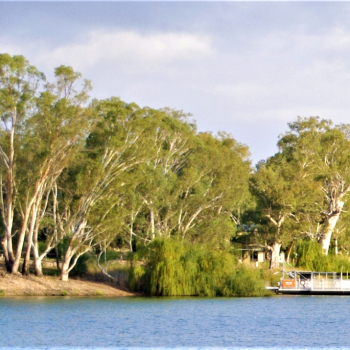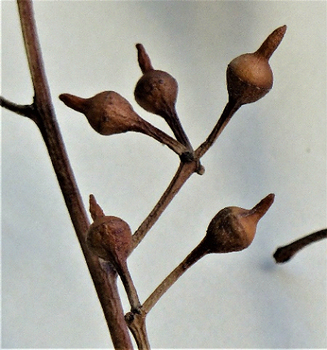Eucalypts

What’s in a name
Let’s start with names. Whether it’s names on a plant nursery label or an interpretation brochure in a national park for the dominant species, there is often a common name and some hard to pronounce name written in Latin for each. The name in Latin is the scientific name it has two parts and is called the species binomial. First is the generic name the second is the species name. Technically this second name is known as the specific epithet. There are no such binding rules for common names although some interest groups like Birds Australia do have a set of acceptable common names.
Jarrah, the common name for a tree from south western, Western Australia is Eucalyptus marginata. Some points to note about this name: an organism, may have multiple common names but only a single scientific name where the genus, Eucalyptus begins with a capital letter and the specific epithet, marginata begins with a lower case letter. Note that both names are in italics because they are written in Latin, a language other than English. It wouldn’t matter if you were to read about this species in an article written in Greek or Arabic script, any reference to the scientific name of an organism will be written in Latin. If you were to flick through a Russian botany book any references to species stands out within the Cyrillic text! Note that once a scientific name has been spelt out in an article, subsequent reference to this species may reduce the genus to a capital as in E. marginata.
While there is only one species called E. marginata, the genus Eucalyptus has some 700 other species. Eucalyptus and its two close relatives Corymbia and Angophora have a total close to 900 species and along with several other genera belong in Family Myrtaceae. To summaries the hierarchy -Species belong in a Genus and several genera make up a Family. There are several other ascending categories in the hierarchy such as Order, Class and Kingdom. In some cases, specimens of a species may be identified as a sub species (abbreviated as spp.), varieties, breeds (as in crop plants or farm animals) or ecotypes -each name is describing a genetically determined variant within a species.
One of the common Eucalypt species is the river red gum, E. camaldulensis and it takes its name from two sources. Eucalyptus has a Greek origin meaning ‘well covered’ and refers to the caps on the flower buds, the operculum. However, ‘camaldulensis’ has a more interesting derivation. Seed of this species were taken from Australia in the early 1800s to Italy to be grown in swampy areas to help reduce surface water, so preventing the reproduction of mosquitoes. In turn, this was aimed at reducing the local malaria problem. One of these river red gums ended up in a garden near Naples -L’Hortus Camaldulensis di Napoli-, and when the species was first scientifically described, the name was based on the source of the specimen – the Camaldoli garden. So, the mostly widely distributed Eucalyptus species in Australia, found along many river banks, has an Italian name!

Some features of Eucalypts
With just a few exceptions Eucalypts have a natural distribution limited to Australia but it happens to be the most widely distributed hardwood planted around the world. As woody plants Eucalypts may vary in size from low growing shrubs to towering forest trees. Forest tree species tend to have a bole (the trunk of a tree up to the branches) that is much higher than the depth of the canopy. By contrast in woodland communities the depth of the Eucalypts canopy is greater than the height of the bole.
Mallee Eucalypts have an umbrella shaped canopy developed on multiple trunks that arise from a large underground wood base known as a lignotuber or mallee root. Growing 0.5 to 9 metres high, mallees are found as the dominant species in Mallee Shrubland commonly found in semi-arid environments across southern Australia. Within Australia there are some 80 million hectares of non-mallee Eucalypt forest and woodland, and 12 million hectares of multi-stemmed mallee.


at least one imperfection.
An interesting story
In my days as a lecturer on Australian flora, after placing a $10 note as a reward on the front bench, I would challenge my students to bring me back an entire undamaged mature Eucalypt leaf after their morning-tea break. I did not every have to pay the reward. However, I would not have offered the same challenge to students when teaching at Arizona State University knowing that there were few natural ‘enemies’ of the many introduced Eucalypts trees growing in the University grounds at Tempe, Az!
Eucalypt Leaves
There is great diversity between species based on leaf characteristics such as length, width, shape of the tip and base, characteristics of the leaf veins and their colour. In most species the mature leaves hang with an isobilateral rather than a dorsiventral orientation. So rather than exposing a wide leaf blade surface face upwards to the sun’s radiation as with the dorsiventral orientation, only the edge of the leaf is exposed with the two large sides receiving most radiation early and late in the day.
However, in their juvenile stages many Eucalypt species do have broad dorsiventral leaves possibly as an adaptation to make rapid growth and so reach a better illuminated situation ahead of their competitors. Juvenile leaves tend to be quite ovate in shape compared to lanceolate in the adult stage and differ from mature leaves in their colour. In some species the juvenile leaves are stemless and may actually clasp the stem.
Except in immature leaves it is difficult in Australian conditions to find a mature Eucalypt leaf that is not partly chewed away, punctured by a leaf sucking insect or playing host to a leaf miner, a scale insect or a batch of insect eggs.
Bark Types
Others with smooth bark may have bark that may falls away or hang in the tree as long ribbons (the ribbon-barks). These smooth barked trees vary from stark white (eg ghost gums), patchy green and grey to the pink salmon gums. Those with a minnerichi bark are a smooth coppery red beneath thin shedding bark that tends to have curled up ends. Iron barks are often quite dark and retain their persistent hard, thick and furrowed bark. Stringy barks have rough bark with shallow furrows and may be pulled off in fibrous strips. One group of species retain their rough bark as a covering part way up the bole (trunk) and are referred to as half barks. With E.miniata, the Darwin wollybutt for example, a species that grows across most of northern Australia, trees may have rough bark up to their lower branches and above these branches are generally smooth barked. By way of contrast, E. tessellaris, Moreton Bay ash, has tile-like bark on the bole that forms a distinctive collar below the grey or white smooth bark above.
Several of the species referred to as bloodwoods, also have this tessellated bark. Strictly speaking, many of the gums, and the bloodwoods having a slightly different floral structure to Eucalyptus due to differences in the structure of their anthers so belong in the closely related genus Corymbia.



Buds and fruits

Eucalypt bud cluster originally with 7 buds. Each bud is spindle shaped with a stalk
that is very short of absent and has a warty surface texture. The fine operculum
suture line maybe distinguished about 1/3 the way from the tip of the bud.
Post-flowering the operculum falls away, the stamens and stigma wither, and it is features of the remaining capsule that become valuable in distinguishing species. The mature capsule is the fruit of eucalypts. There is clearly variation in capsule shape and in some species the disc (the scar left by the fallen stamens) on the capsule rim may be ascending or otherwise. The valves are teeth-like structures that control the release of seed from inside the fruit. The valves vary in number and depending on species the valves may be enclosed well inside the capsule or exserted.

Clusters of mature Eucalypt fruits. Each appears to be stalkless, hemispherical in
shape with an ascending disc (to which the stamens were attached), the thin scar left
by the operculum outside this and three, near-level valves.
E. camaldulensis, river red gum has stalked buds arise from the axis of leaves, in groups of 7 to 11 in number and have a beaked operculum. The fruits are small 0.3x1cm, the disc is ascending and the valves are exserted. Distinguishing features of E. miniata, the Darwin wollybutt, beside its brilliant orange flowers are its large ribbed fruits, without stalks, that measure 6x5cm with deeply enclosed valves.

The beaked operculum of
E. camaldulensis, river red gum buds

E. platyphylla Horn Island, Torres Straight QLD.
Regeneration
Fire is a fairly common feature in most natural Australian environments and Eucalypts have adaptive mechanisms to respond to this destructive natural force. With mallee species the lignotuber is the source of canopy regeneration following fire. Multiple shoots sprout up from the lignotuber and a few of these survive to form new trunks and branches to re-establish the burnt plant. In many other Eucalypts like the gums, stringy barks and iron barks, buds lying under the bark (called epicormic buds) are stimulated following defoliation by fire and their growth produces branches and leaves to replace the canopy.
Two species, alpine ash (E. delegatensis) and mountain ash (E. regnans) form large areas of the Victorian forests and they are examples of Eucalypts that regenerate from seed. Fire in forests of alpine and mountain ash not only clears the ground surface but stimulates mature trees to shed their seed. The dropped seed germinates in the fire ash and after 80 to 100 years trees reach maturity. As a matter of interest mountain ash is the tallest growing hardwood with trees over 100 metres high and one recorded at 132 metres. The karri (E. diversicolor) in Western Australia runs a close second to the mountain ash. These and other large (in height and girth) old trees may live for several 100 years and hollows in their trunks are ideal habitats for possums and birds.
A few of the Eucalypt species from northern Australia are deciduous and loose a large proportion of their leaves during the dry season. Regeneration is evident during the build-up prior to the wet season onset. E.platyphylla, the poplar gum, is a species that is often deciduous during the dry season.

